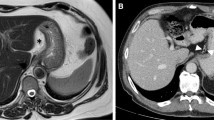Abstract
This paper reports two cases of cadaveric cystoduodenal ligament in the lesser omentum, different from the commonly known hepatoduodenal and hepatogastric ligaments. Cystoduodenal ligament was occasionally reported and implies a variation in the anatomy of the omental bursa and its foramen. The omental foramen which has been commonly described to provide communication between the greater and the lesser sacs, and located posterior to the free egde of the lesser omentum, is not so in these cases. The knowledge of abnormal peritoneal folds like this may be important to surgeons, prosectors and radiologists.



Similar content being viewed by others
References
Borley NR, Collins P, Healy J (2008). Development of the peritoneal cavity, gastrointestinal tract and its adnexae. In: Standring S, Gray H (eds). The Anatomical Basis of Clinical Practice, 40th edn. Churchill Livingstone, London, pp 1214–1215
Colak T, Dalcik C, Ozbek A, Filliz S, Sahin M, Dalcik H (2002) A rare multiple variation of the greater omentum. Okajimas Folia Anat Jpn 79(5):159–162
Desai G, Filly R (2010) Sonographic anatomy of the gastrohepatic ligament. J Ultrasound Med 29:87–93
Filly RA, Marglin S, Castellino RA (1976) The ultrasonographic spectrum of abdominal and pelvic Hodgkin’s disease and non-Hodgkin’s lymphoma. Cancer 38:2143–2148
King L, Siegel MJ, Balfe DM (1995) Acute pancreatitis in children: CT findings of intra- and extrapancreatic fluid collections. Radiology 195:196–200
Low VH, Davis SJ, Yoong MS (1992) Anomalous peritoneal folds of the duodenum. A normal variant simulating disease. Austral Radiol 36(2):135–136
Liu C, Wu TC, Tsai HL, Chin T, Wei C (2005) Obstruction of the proximal jejunum by an anomalous congenital band: a case report. J Pediat Surg 40(3):27–29
Moore KL, Dalley AF (1999) Abdomen. In: Clinically oriented anatomy, 4th edn. Lippincott Williams & Wilkins, Baltimore pp 209–217
Moore KL, Persaud TVN (2003) The developing human: clinically oriented embryology. Saunders, Philadelphia, pp 256–275
Netter FH, Dalley AF (2006) Atlas of human anatomy, 4th edn. Saunders Elsevier, Philadelphia, p 275
Pamidi N, Nayak S, Vollala VR (2008) Cystogastrocolic fold and associated atrophy of the gall bladder. Singapore Med J 49(9):250
Romanes GJ (2007) Cunningham’s manual of practical anatomy, 15th edn, vol 2. Oxford University Press, New York, pp 122–129
Satheesha NB (2009) Abnormal peritoneal fold connecting the greater omentum with the liver, gall bladder, right kidney and lesser omentum. Bratish Lek Listy 200(11):736–737
Shaikh AA, Charles A, Domingo S, Schaub G (2005) Gall bladder volvulus: report of two original cases and review of the literature. Amer Surg 71(1):87–89
Siegelman SS, Copeland BE, Saba CP, Cameron JL, Sanders RC, Zerhouni EA (1980) CT of fluid collections associated with pancreatitis. AJR Am J Roentgenol 134:1121–1132
Tzardinglou E, Prousalidis J, Apostolidis S, Katsohis C, Aletras H (1996) Hanging non-calculous gall bladder. HPB Surg 9(3):137–139
Williams PL, Banister LH, Berry MM, Patricia C, Dyson M, Dussek JE, Ferguson MWJ (1995). The Peritoneum. In : Gray’s Anatomy 38th edn. Churchill Livingstone, New York, pp 1734–1745
Conflict of interest
We hereby categorically declare that there was no conflict of interest whatsoever associated with this work. The authors are seasoned academics and researchers of the host institute, Bowen University and are duly mandated to carry out their work under the aegis of their employer. Furthermore, the discovery herein reported was observed during routine practical dissection classes supervision. There was no financial sponsorship for this research, all financial input were from the above named researchers.
Author information
Authors and Affiliations
Corresponding author
Rights and permissions
About this article
Cite this article
Ashaolu, J.O., Ukwenya, V.O. & Adenowo, T.K. Cystoduodenal ligament as an abnormal fold and the accompanying anatomical and clinical implications. Surg Radiol Anat 33, 171–174 (2011). https://doi.org/10.1007/s00276-010-0736-z
Received:
Accepted:
Published:
Issue Date:
DOI: https://doi.org/10.1007/s00276-010-0736-z




